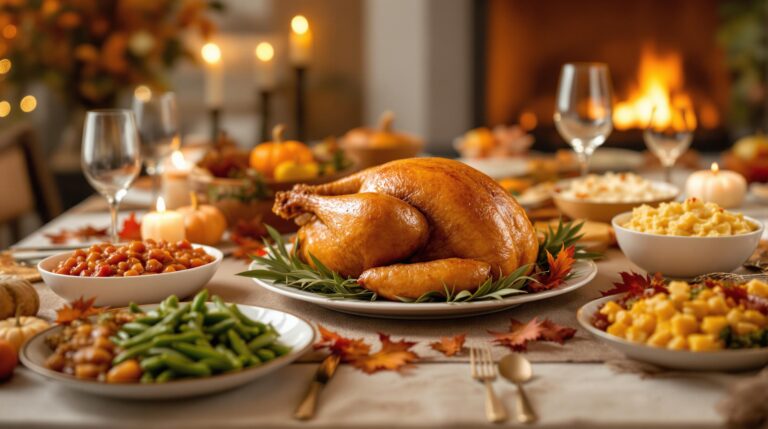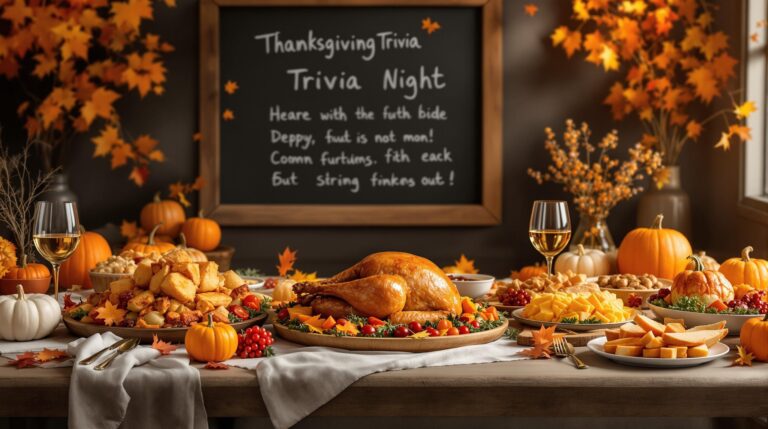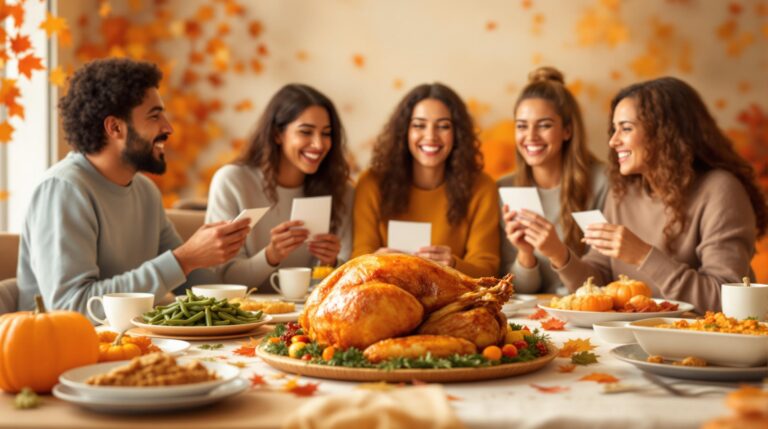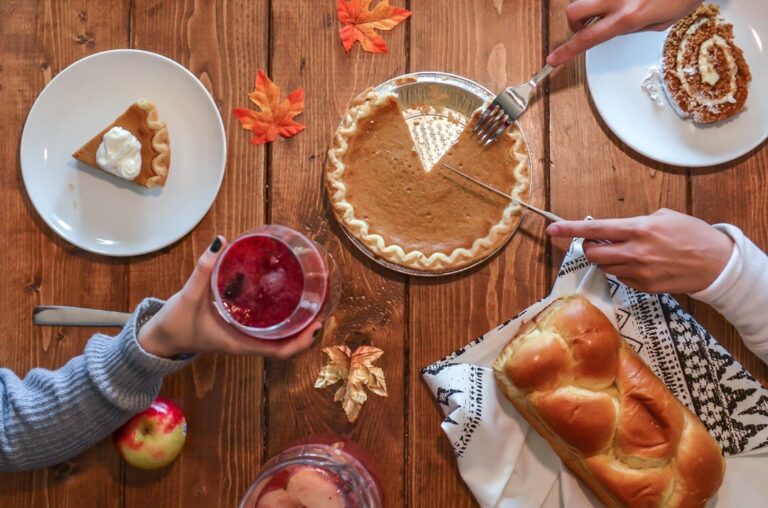Thanksgiving Trivia: An In-Depth Look at the Holiday’s History and Customs Thanksgiving is a beloved holiday in the US, marked by feasts, family get-togethers, and an attitude of thankfulness. Nonetheless, this holiday’s history and development are intricate and varied. From Thanksgiving’s historical origins to its contemporary significance, this article will examine many facets of the holiday and offer insightful information that will help you better comprehend and value this cherished holiday. Need Weekly Trivia Questions? https://cheaptrivia.com/products/weekly-trivia-subscription-service
Key Takeaways
- Thanksgiving originated from the harvest festivals celebrated by the Pilgrims and Native Americans in the early 17th century.
- The first Thanksgiving feast in 1621 was a three-day event attended by 53 Pilgrims and around 90 Native Americans.
- Thanksgiving became a national holiday in 1863, when President Abraham Lincoln proclaimed it as a day of “Thanksgiving and Praise to our beneficent Father who dwelleth in the Heavens.”
- Native Americans played a crucial role in the first Thanksgiving feast and continue to be an important part of the holiday’s history and traditions.
- Thanksgiving has evolved over time, with new traditions and foods being added to the celebration, and has also influenced American culture and popular culture.
Since the English Pilgrims arrived in North America in the early 17th century, Thanksgiving has existed. A group of these pilgrims arrived on the Mayflower in 1620 in search of a fresh start and religious freedom. Following a difficult first winter, they established ties with the Wampanoag tribe, who taught them vital survival skills like fishing and corn cultivation.
This partnership established the foundation for the eventual Thanksgiving holiday. Many people believe that the first Thanksgiving was a three-day harvest celebration that took place in November 1621. At first, the celebration of the Pilgrims’ bountiful harvest was a communal feast rather than a formal holiday. Fifty Pilgrims and about ninety Native Americans attended, and despite the difficulties both groups faced, it was a time of gratitude and solidarity.
Although Thanksgiving was observed in several colonies over the years, the holiday didn’t take on its current form until much later. Since their inception, Thanksgiving customs have undergone significant change. Gatherings for a communal feast and thanksgiving for the harvest characterized the early festivities. But over time, a number of customs started to appear. For example, the Pilgrims’ religious convictions & desire to recognize divine providence were reflected in the custom of offering thanks before meals, which spread throughout society. Early Thanksgiving festivities frequently included games & activities in addition to prayer and feasting.
They included fishing, hunting, & even family competitions. With the expansion & diversity of communities, Thanksgiving customs also changed. Many families now add distinctive traditions that are a reflection of their cultural heritage, giving each celebration a unique feel while still paying homage to the holiday’s origins.
The collaborative efforts between the Pilgrims and Native Americans were exemplified by the historic first Thanksgiving feast in 1621. The menu, which featured venison, poultry (probably wild turkey), corn, beans, squash, and a variety of fruits and nuts, was very different from what you might expect today. American cuisine has changed significantly over the centuries, as evidenced by the lack of contemporary staples like pumpkin pie and mashed potatoes. In contrast to the organized meal we now associate with Thanksgiving, this first feast, which lasted for three days, was marked by a spirit of friendliness. By sharing food & stories, the Wampanoag and Pilgrims created a sense of community that cut across cultural boundaries. Setting the standard for Thanksgiving celebrations in the future, this event focused on unity, sharing, and thankfulness.
Prior to President Abraham Lincoln declaring Thanksgiving a national holiday in 1863 during the Civil War, the holiday was observed regionally for many years. A well-known author who spent almost 17 years advocating for a national day of gratitude, Sarah Josepha Hale, had an impact on Lincoln’s choice. She thought that during a time of division, such a holiday could promote unity among Americans. Thanksgiving was declared a national holiday by Lincoln, and it is observed on the final Thursday of November.
At a turbulent time in American history, this action not only strengthened the holiday’s meaning but also contributed to the development of a feeling of national identity. Over time, Thanksgiving was embraced by families all over the country and became a significant aspect of American culture. Mainstream narratives frequently ignore Native Americans’ significance in Thanksgiving. Despite the fact that the Pilgrims are usually given credit for creating the holiday, Native Americans were instrumental in its inception.
During the Pilgrims’ first year in America, the Wampanoag tribe’s support was essential to their survival. Thanksgiving is now observed as a day of mourning rather than celebration in many Native American communities. They consider the effects of colonization as well as the loss of their native cultures and lands. Although Thanksgiving is a time for many people to express gratitude and spend time with their families, this viewpoint serves as a reminder that the holiday also has significant historical significance that should be recognized and honored.
Thanksgiving celebrations have changed dramatically over time, adjusting to shifting cultural influences and societal norms. As merchants realized Thanksgiving could increase sales, it started to take on more commercial elements in the early 20th century. Parades that highlighted floats, performances, & a sense of community, like the well-known Macy’s Thanksgiving Day Parade in New York City, gained popularity. In the modern world, Thanksgiving has evolved into a complex holiday that incorporates many customs. Even though a lot of families still get together for big feasts that include turkey and stuffing, some have adopted other holidays that are more representative of their own cultural backgrounds or tastes.
Thanksgiving’s ongoing adaptation while preserving its central themes of thankfulness & community is demonstrated by this evolution. Thanksgiving foods are deeply rooted in history & represent both European and Native American culinary customs. Although turkey is now often associated with Thanksgiving, it wasn’t always the main course of the original Thanksgiving dinner.
Instead, wild poultry—of which turkey was one of several varieties—were more prevalent. Other customary foods have changed over time as well. Cranberry sauce, for instance, has its roots in Native American cooking; long before European settlers came, they used cranberries for both culinary and medicinal purposes.
Similarly, because it was readily available in North America and was incorporated into early colonial cooking techniques, pumpkin pie became a popular dessert. Your appreciation of Thanksgiving cuisine is enhanced when you are aware of these origins. Although Thanksgiving is largely connected to American culture, other nations celebrate harvest festivals that are comparable to it. Canada, for example, celebrates Thanksgiving on the second Monday in October, following customs that are similar to those in the US but have distinctive regional differences.
Although they may not be referred to as “Thanksgiving,” harvest festivals in other cultures have similar themes of appreciation & communal celebration. For instance, Japan celebrates Kinrō Kansha no Hi (Labor Thanksgiving Day) on November 23rd to recognize the contributions made by workers to society. These diverse viewpoints on gratitude show how universal themes can appear in a variety of cultural contexts. Beyond just food and family get-togethers, Thanksgiving has had a significant impact on American culture. Reflection on virtues like thankfulness, generosity, and camaraderie has become a part of it. Thanksgiving is not only about celebrating oneself but also about giving back to others, as evidenced by the large number of people who use this occasion to volunteer at shelters or give food to those in need.
Thanksgiving has also served as an inspiration for a variety of artistic, musical, and literary expressions. These cultural artifacts, which range from beloved novels that portray family get-togethers to tunes that celebrate the holiday spirit, help Americans today share a common understanding of what Thanksgiving means. In literature, television, and film, Thanksgiving has left its mark on popular culture. While tackling themes of friendship and community, classic movies like “A Charlie Brown Thanksgiving” encapsulate the spirit of the holiday’s childhood nostalgia.
Likewise, Thanksgiving episodes of sitcoms on television frequently showcase family dynamics and amusing mishaps that occur during holiday preparations. These representations help to mold how the general public views Thanksgiving and reaffirm its importance as a time for introspection and family time. Think about how these stories relate to your own experiences and customs as you interact with popular culture this season.
Thanksgiving is a crucial reminder in today’s hectic world to take a moment to consider what really counts in life: family, friends, and thankfulness for all that we have. It offers a chance to break away from everyday schedules and reestablish relationships with loved ones over meals & experiences. Also, as society grows more diverse, celebrations in the modern era frequently include a variety of cultural components that enhance customs.
People from various backgrounds can unite in appreciation of one another’s heritage thanks to this blending of customs, which promotes inclusivity. In summary, knowing the background and customs of Thanksgiving deepens your appreciation for this cherished occasion. Thanksgiving continues to develop while staying a vital component of American culture, having its roots in intercultural cooperation and its current significance as a time for reflection and thankfulness.
What really makes this holiday special is embracing the spirit of togetherness, whether you celebrate with traditional foods or distinctive customs that represent your heritage.
If you’re interested in learning more about Thanksgiving trivia, you may want to check out this article on 10 Interesting Facts About Thanksgiving to Excite Your Customers. This article provides fun and engaging facts about the holiday that are sure to impress your friends and family at your next Thanksgiving gathering.
GRAB YOUR FREE HOLIDAY TRIVIA PACKS
FAQs
What is the origin of Thanksgiving?
Thanksgiving originated as a harvest festival, celebrated by the Pilgrims in 1621, to give thanks for a successful harvest and the help of the Native Americans.
When is Thanksgiving celebrated?
In the United States, Thanksgiving is celebrated on the fourth Thursday of November. In Canada, it is celebrated on the second Monday of October.
What are some traditional Thanksgiving foods?
Traditional Thanksgiving foods include roast turkey, stuffing, mashed potatoes, cranberry sauce, and pumpkin pie.
What is the significance of the turkey in Thanksgiving celebrations?
The turkey has become a symbol of Thanksgiving because it was a staple food for the Pilgrims and Native Americans during the first Thanksgiving feast.
How do people celebrate Thanksgiving?
People celebrate Thanksgiving by gathering with family and friends for a festive meal, often including traditional foods, and expressing gratitude for the blessings in their lives. Some also participate in parades, watch football games, or volunteer to help those in need.






